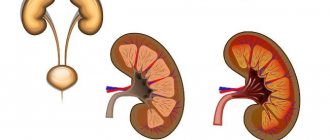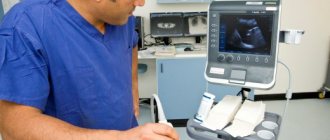Why a bad urine test during pregnancy: reasons
The most common analysis throughout the entire 9-month period is urine testing.
In this way, the functioning of the bladder and kidneys can be assessed. Bad urine during pregnancy often indicates the presence of harmful microorganisms or that the filtration process is impaired, which means that the kidneys are not coping with their functions properly. Doctors recommend retaking the initial bad urine test during pregnancy to exclude the possibility of incorrect results due to non-compliance with the rules for urine collection. If repeated research does not show improvement, then the reasons for the situation may lie in the following factors:
- pressure in the later stages of a growing fetus on the internal organs, which leads to difficult outflow and stagnation of biological fluid;
- bacteria in a pregnant woman’s body not only provoke abnormalities in tests, but also threaten infection of the fetus and subsequent intrauterine growth retardation;
- long-term toxicosis at any stage is dangerous for both the child and the expectant mother, the body quickly becomes dehydrated;
- nephropathy and inflammatory processes in the urinary system interfere with the normal functioning of internal organs.
In addition, deviations in tests are often provoked by multiple pregnancies, the formation of a large fetus, and in the early stages indicates a normal physiological reaction of the body to the changes taking place.
Preparing for a urine test
Not many people know that if you prepare incorrectly for the test, you can get false results, and as a result, anxiety and sometimes even unnecessary treatment.
To get accurate results you must:
- The day before the test, do not overexert yourself. There is no need to do spring cleaning, shopping, or go to the gym (even to yoga). Any excessive physical activity leads to the appearance of protein in the urine.
- Avoid salty, fried, and spicy foods, because these foods can also contribute to the appearance of unnecessary protein in the urine.
- It is better to use sterile containers to collect urine. If it is not possible to go to the pharmacy and buy a specially prepared sterilized jar for collecting urine, then it is best to take a small one from baby food and wash it with a weak soda solution.
- You only need to collect urine in the morning, immediately after waking up. This must be done because it is at this time that all deviations will be visible. Many people have noticed that morning urine differs from daytime urine in a stronger smell and color. This is because the kidneys work in a slightly different mode. And it is precisely in this urine that deviations can be seen.
- Before you start collecting urine, you need to wash yourself well. Some doctors advise women to insert a cotton swab into the vagina for only one purpose, so that the discharge does not end up in the jar.
- It is necessary to fill the jar with an average portion of urine. To do this, literally for the first few seconds you need to urinate into the toilet, and only then into the container. Moreover, you don’t need to fill the jar to the brim; half is enough.
When transporting the analysis to the laboratory, you need to be as careful as possible so that the test jar does not shake and foam does not form. It is often this shaking and foaming that causes inaccurate results.
In addition, it is best to deliver tests within two hours of collection. Otherwise, they may also show a false result, and they will have to retake it again.
Why bad urine during pregnancy: consequences
If the general analysis shows complicated results, a urine test according to Nechiporenko is prescribed. The principle of urine collection remains the same, but the analysis is carried out taking into account sediment per 1 ml of liquid.
As a result of such studies, the following can be identified:
- A white blood cell count of more than 6 indicates inflammation in the kidneys or bladder. The higher the indicator, the more severe the consequences for intrauterine formation.
- Protein must be absent; the presence of this element threatens the development of pyelonephritis or preeclampsia;
- Ketone bodies indicate a complication of diabetes mellitus or the development of early toxicosis;
- Glucose in small quantities is allowed only in the last months, otherwise it is an indicator of the formation of diabetes mellitus;
- Red blood cells should not be present in urine; the appearance of blood is a clear sign of the development of the disease and the threat of miscarriage;
- Salts are a sign of poor nutrition, which can lead to urolithiasis.
If an infectious progressive process in the kidneys was detected at 35 weeks of gestation, then a decision is often made about early delivery. Since the failure of the functioning of the urinary system leads to the entry of toxic substances into the uterine cavity and to the death of both mother and child.
Interpretation of urine analysis in pregnant women
Urine analysis during pregnancy includes the study of:
- external parameters;
- physical and chemical properties;
- chemical compounds in the composition;
- draft.
- The volume of the first portion of urine in the morning (150-250 ml);
- Color;
- Transparency;
- Specific gravity is in the range of 1010-1030.
In addition to a general urine test, a woman may be prescribed additional tests during pregnancy.
Analysis according to Nechiporenko
This urine analysis evaluates its cellular composition.
It is prescribed for:
- high level of red blood cells, white blood cells, casts in the general analysis;
- signs of kidney disease in pregnant women;
- monitoring the progress of treatment.
Deciphering a urine test in pregnant women involves assessing the results taking into account the norm and accompanying symptoms. Therefore, only a doctor should evaluate the response to a urine test in order to make a correct diagnosis.
When diagnosing, the following indicators are taken into account:
- Lack of protein is normal. If the quantity is minimal, one may suspect incorrect collection of the test material or significant physical activity the day before. If the protein exceeds normal parameters, then additional examinations are prescribed for the presence of pyelonephritis or gestosis.
- Leukocytes are cells of the body's defense system, so their increased content in the urine becomes direct evidence of infection in the kidneys or genitourinary organs.
- Glucose becomes a sign of diabetes mellitus or gestational diabetes, which is accompanied by constant thirst and frequent urination.
- Ketones appear in tests during prolonged dehydration, when the body is forced to feed on its own fat deposits.
- Bilirubin - indicates liver failure.
- Red blood cells should be in minimal quantities. The appearance of blood cells in the urine is associated with damage to internal organs and bleeding.
- Epithelium during pregnancy is considered a normal manifestation, but elevated levels, depending on the type of epithelial cells, indicate the localization of the pathological process.
- Salts are present in minimal parameters, an increased amount indicates the development of urolithiasis;
- Bacteria are a clear sign of an inflammatory and infectious process.
- The cylinders, together with proteins, indicate disturbances in the functioning of the kidneys.
If the test results are not satisfactory and require more accurate data, then more accurate methods are used to diagnose kidney diseases. In particular, it is able to determine quantitative indicators of leukocytes and erythrocytes. For a more detailed examination, a flora culture tank is used, which is carried out over a long period (about 10 days), but is able to determine not only the type of infection, but the most effective medicine to combat harmful bacteria.
If the results are poor, a repeat test is often prescribed. If the parameters have not changed, then a pathology that threatens the normal development of the child should be diagnosed. After which, adequate treatment is prescribed using drugs approved during pregnancy.
What to do if you have bad urine during pregnancy?
Treatment for poor analysis is prescribed by the doctor after a thorough diagnosis. Before treatment, additional examinations of urine and internal organs are prescribed. Depending on the woman’s condition, it is recommended to prevent edema reactions and reduce salt intake. The diet includes restrictions on fried and canned foods.
If there is a threat of premature birth, then in a hospital setting, medications are used to maintain pregnancy. Constant measurements of blood pressure are carried out and studied over time so as not to miss the occurrence of complications.
During pregnancy, it is especially important for a woman to feel good, because she is already responsible for two lives - not only her own, but also that of the child. To monitor the condition of the expectant mother, a variety of laboratory and instrumental tests are performed, selected by the doctor depending on the gestational age and the individual characteristics of the patient’s body. A poor urine test during pregnancy is alarming news; of course, it requires attention and correct interpretation.
This is a colloquial expression that is used to indicate the presence of indicators in the research results recorded on the form that are beyond the limits of normal variations.
Physiological changes in the urinary system during pregnancy
During pregnancy, the expectant mother's kidneys work more intensively, since they are faced with the task of evacuating from the body not only the products of their metabolic processes, but also the metabolic products of the fetus. Many women ask whether a urine test shows pregnancy. Unfortunately, it is impossible to determine the presence of pregnancy using a general urine test; there are other methods for this, such as the hCG test.
In the first 12 weeks of pregnancy, blood flow increases, and therefore all organs begin to receive a larger volume of circulating blood. Filtration of the glomeruli increases, and reabsorption of the tubules does not change throughout pregnancy, which causes the development of edema and fluid retention in the body.
As the uterus enlarges, the position of the internal organs changes. During the third trimester, the bladder moves upward outside the pelvis and its walls thicken to withstand increased pressure from the uterus. In rare cases, hydroureter occurs - a violation of the patency of the ureter, usually the right one. This is explained by its compression at the level of the pelvic bone.
Under the influence of progesterone, the tone of the urinary tract decreases, they expand, as a result of which the infection more easily penetrates the bladder with the subsequent development of pyelonephritis.
Causes
Why might urine test results change during pregnancy? To answer this question you will need much more space than one article, so it is worth focusing on the most common reasons.
According to statistics, this is one of the most common reasons for poor tests in women during gestation. This category includes:
- Local lesions in the urinary tract area. These are cystitis, urethritis, various types of nephritis, that is, kidney damage.
- Systemic diseases accompanied by fever, changes in metabolic activity, cell and tissue damage. Most often these include infectious – viral, bacterial, fungal – pathologies.
During inflammation, test data may change:
| Index | Process type | |
| Local (meaning location in the area of the urinary tract, kidneys) | System | |
| Protein | Maybe ↑ | |
| Leukocytes | ↑ | Most often without features |
| Bacteria | Probably negligible ↑ to high | |
| Red blood cells | ||
| Cylinders | Sometimes they appear | |
All of the listed disorders are not directly related to pregnancy and can also be found in women of any age outside the gestation period (gestation). However, they can also develop while waiting for the birth of a child and, accordingly, will be reflected in the results of a urine test.
This is a pregnancy-specific condition that causes blood glucose levels (glycemia) to rise above normal. The examination is carried out using material taken from a vein; the results of urine testing should not be the basis for establishing a diagnosis.
However, they are used to assess the risk of complications and adjust therapy; Data may change:
- glucosuria, or the release of sugar in the urine - healthy women do not have it, it appears if the glycemic level is above 8.88 mmol/l;
- ketone bodies, or acetone, are normally absent altogether; they are detected in metabolic disorders (metabolic acidosis) and require medical correction.
This is a complication of pregnancy, which develops from the 20th week of gestation and is characterized by a triad of signs:
- Increased blood pressure, that is, hypertension.
- The occurrence of edema.
- The appearance of protein in the urine is proteinuria.
Please note that the figures are for 24-hour urine (collected over 24 hours).
Changes in urine analysis in a pregnant patient may be due to conditions such as:
- chronic kidney dysfunction;
- asymptomatic bacteriuria;
- hereditary syndromes associated with autoimmune inflammatory processes;
- taking medications;
- intoxication with poisons, pharmacological agents;
- neoplasm in the urinary tract area or outside its boundaries.
At the same time, the level of leukocytes and erythrocytes may increase, casts, bacteria are detected, epithelial cells appear in layers, in large numbers, often in a transformed form, which makes their identification difficult.
Medicines can provoke a change in the color of urine, and then the alarm will be false - if the doctor does not know what pills the woman is taking, he will not be able to correctly evaluate the laboratory report.
As for intoxications, a variety of changes are possible, including the appearance of hemoglobin in the urine. Tumor processes are often accompanied by the release of red blood cells in large quantities, but this cannot be considered a typical sign; such diagnoses are not established by urine analysis.
results
Many women are interested in deciphering a urine test during pregnancy. But it should be understood that only a doctor makes a conclusion about certain processes in the body. Therefore, you need to focus on other sources of information carefully, especially when interpreting pathology. After all, no one wants to worry unnecessarily when carrying a child, and an incorrect diagnosis, and especially independent treatment, are associated with real risks. But normal indicators are available in various reference materials and do not pose a danger to anyone.
Physicochemical properties and microscopic examination of urinary sediment are considered mandatory parameters for general or clinical analysis, including during pregnancy. The table below shows the main indicators and the corresponding physiological values:
Thus, the results of a general urine test during pregnancy should not differ from those of non-pregnant women. And although the urinary system is under serious stress, compensatory capabilities smooth out these changes without going beyond physiology. But the appearance of any deviations indicates one or another pathology.
Possible complications
Adverse consequences depend on what kind of pathology we are talking about. A urine test is a test that provides general information. To avoid confusion, it must be interpreted depending on the patient’s condition, the results of other tests, and specific complaints. Therefore, we will analyze only those cases that have already been discussed in the previous paragraph.
So, the inflammatory process - both in the urinary tract and systemic - can threaten with such consequences as:
- Spread (from the initially affected area to nearby areas).
- Worsening (up to sepsis, if there is a bacterial infection).
- Chronization (that is, the occurrence of a constantly existing unfavorable focus).
Severe inflammation adversely affects the condition of the expectant mother and child; there is a high risk of infection of the fetus during pregnancy or childbirth.
Gestational diabetes can lead to:
- severe metabolic disorders;
- a sharp worsening of the severity of the condition;
- to whom.
Of course, in such a situation, not only the expectant mother will suffer, but also the child - growth and development delays, and oxygen deficiency are likely.
Preeclampsia is dangerous due to the possible consequences:
- Delayed growth and development of the child.
- Chronic hypoxia (oxygen starvation) of the fetus.
- Premature birth.
It can lead to an attack of seizures - eclampsia. This is an emergency condition that requires qualified medical care to avoid the death of the woman and child.
Intoxications have different effects; a mild degree may not be detected objectively (that is, there are no complaints), and only deviations from the norm are observed in the analysis. In case of severe poisoning, hypoxia, impaired growth and development of the fetus, and termination of pregnancy are possible.
Pathological conditions
There are a huge number of diseases that can be suspected based on irregularities in urine analysis alone. Each indicator is important, but the following are most important during pregnancy:
- Color changes (dark brown, red, black, blue-green, whitish).
- Deviations in specific gravity (hypo-, hyper-, isosthenuria).
- Reduced clarity or turbidity.
- High protein (proteinuria).
- The appearance of glucose (glucosuria).
- Increase in leukocytes (leukocyturia).
- Increased red blood cells (micro- or macrohematuria).
- Detection of bacteria (bacteriuria).
These are the main pathological changes that can await a woman. How intense the deviations from the norm will be depends on the type of pathology and its degree. We can talk not only about diseases of the urinary system, but also about disorders of other organs.
Deviations in the main indicators of urine analysis indicate various pathologies - not only nephro-urological, but also covering other body systems.
Alarming symptoms
Regardless of which trimester of pregnancy is observed, a urine test is necessary if a woman is concerned about:
- persistent nausea, repeated vomiting;
- headache;
- weakness;
- discomfort when urinating;
- fever;
- change in the color or smell of urine;
- weight loss.
If you have preeclampsia, you should pay attention to the following signs:
You cannot ignore the occurrence of pain:
All expectant mothers, without exception, are prescribed general blood and urine tests several times. It often happens that the results do not satisfy doctors - after all, some indicators may indicate the presence of a pathology in the body, which can lead to an unfavorable end of pregnancy or a deterioration in the condition of both mother and child.
When examining urine, doctors pay attention to its color, transparency, and the presence of various substances - in particular, protein, red blood cells, white blood cells, or casts.
HCG analysis
Using standard urine tests, it is impossible to accurately diagnose a woman’s pregnancy, especially in the early stages.
The onset of pregnancy is shown by a urine test for hCG. HCG or human chorionic gonadotropin is a specific hormone protein that is produced by the membranes of the developing embryo throughout pregnancy. This protein is necessary for the normal development of pregnancy.
Thanks to human chorionic gonadotropin, the processes that cause menstruation are blocked in the body of the expectant mother and the production of hormones that are necessary to maintain pregnancy increases. Thus, an increased level of hCG in a woman’s blood and urine can be called one of the earliest signs of pregnancy, which is used for diagnosis.
In a normally developing pregnancy, a urine test shows a hCG concentration of more than 50 mIU/ml on the fifth to seventh day after conception. Thanks to this method of urine examination, pregnancy can be established already in the first or second week after conception.
To test urine for hCG, take the last portion of morning urine, which is collected in a clean container. The study is carried out within 25–30 minutes. The diagnostic accuracy of this method is 98%.
False negative reaction
A false negative reaction during this study can occur if the pregnancy is too short, an ectopic or impaired uterine pregnancy, or necrosis of chorionic tissue.
False positive reaction
A false positive reaction is observed in some gynecological diseases, tumors of the ovary or pituitary gland, inflammatory diseases of the genital organs, during menopause and menopause. Taking certain medications (phenothiazine derivatives, tranquilizers, alkaloids) can also cause a false positive reaction to hCG.
The principle of operation of most pregnancy tests is also based on the reaction to human chorionic gonadotropin. But laboratory urine testing is significantly more accurate than self-administered pregnancy tests.
How to treat
- Repeated study. If you have taken a general urine test, you will be given a referral for Nechiporenko tests to determine the exact content of leukocytes, red blood cells or casts. Often it is also necessary to take a daily test, or according to Zimnitsky;
- Constantly monitor blood pressure - it is important to record all indicators on the exchange card and monitor the dynamics;
- Prevention of edema - restriction of liquids, salty foods;
- Limiting or completely eliminating fried foods from the diet - it is best to stew or steam them;
- Physical activity - walking in the fresh air;
- Medicines that can cope with various problems.
Regardless of the reason for the negative test result, you may need to go to hospital for a while under medical supervision. There, treatment is carried out with the necessary medications and constant monitoring of the condition.
Carrying out analysis
First of all, a woman should know how to properly collect urine for analysis. After all, errors at the first stage affect the reliability of the results obtained. Not everyone knows about the rules for collecting urine, and they are often simply embarrassed to ask a gynecologist. Therefore, this issue requires additional coverage. Having received a referral for analysis, a pregnant woman should remember the following:
- On the eve of the study, adhere to your usual drinking and dietary regimen.
- Prepare a clean disposable container (plastic container) in advance.
- Immediately before the procedure, perform thorough hygienic treatment of the genitals.
- Collect the morning average portion (first urinate in the toilet, then in a jar, and then again in the toilet).
- The amount of urine should be at least 50 ml.
- Deliver the material to the laboratory within 2 hours (storage only in the refrigerator is allowed).
All of these aspects have a certain significance. If the container is dirty or urine is stored for a long time in inappropriate temperature conditions, sediment or turbidity will appear in it, and bacteria may develop. An admixture of leukocytes and mucus often indicates improper toileting of the genital organs, when physiological discharge - leucorrhoea - comes from the vagina. And if you donate less urine than required, the laboratory will not be able to determine all the necessary components, for example, relative density or some biochemical indicators.
It is important to correctly collect urine for general analysis, because the informativeness and reliability of the results depends on this.
What does it lead to?
What are the dangers of bad urine for pregnant women? In fact, the situation is much more serious than it might seem at first glance, because any inflammation or infection can negatively affect the baby’s health. Therefore, it is very important not to let the situation take its course:
- Pyelonephritis, a sign of which is the presence of leukocytes, can cause hypoxia or infection of the child in the womb. Moreover, sometimes this disease leads to miscarriage and subsequent miscarriage;
- High protein leads to problems such as delayed fetal development or premature birth. It is often accompanied by a dangerous condition such as preeclampsia, which can result in the death of the mother or child;
- An increase in sugar levels leads to an increase in the size of the baby, and can also increase his risk of developing diabetes in the future;
- If salts are found in the urine, this can cause thinning of the child's skeletal bones.
Any illness of the expectant mother requires treatment, because the deterioration of her condition necessarily affects the baby.
Cystitis during pregnancy:
The administration of the portal categorically does not recommend self-medication and advises consulting a doctor at the first symptoms of the disease. Our portal presents the best medical specialists with whom you can make an appointment online or by phone. You can choose the right doctor yourself or we will select one for you absolutely free. Also, only when you make an appointment through us, the price for a consultation will be lower than in the clinic itself. This is our little gift for our visitors. Be healthy!
Urine examination is a simple but informative way to assess the condition of the genitourinary system and kidney function. A poor urine test during pregnancy indicates that the woman’s body cannot cope with the stress of bearing a child.
The main reasons for deviations in indicators.
- Failure to comply with delivery rules. Spicy, fried, smoked or colored foods can distort the result, so they are excluded several days before urine collection. When preparing, you need to take the same responsibility for genital hygiene and sterile processing of the container for biomaterial. The morning urine collection is taken for analysis, and only the middle portion. It is important to inform your doctor in advance about taking medications. If you passed it incorrectly, repeat the procedure.
- Multiple pregnancy or a large child causes disruption of the filtration organ and poor test results.
- An increase in the size of the uterus provokes increased pressure on the inferior vena cava and the child puts pressure on the kidneys.
- Nephropathy is a dangerous pathology that causes arterial hypertension. As a consequence, placental dysfunction is noted after 30 weeks of gestation.
- Severe toxicosis in the first trimester or gestosis in later stages is accompanied by swelling, increased blood pressure, an increase in the amount of protein in the urine and a cast in the analysis.
- An inflammatory process in the kidneys or organs of the excretory system that occurs in a pregnant woman affects the characteristics of urine, and pressure may increase.
- A history of pathologies of the excretory tract.
- Negative tests can be observed due to a salt-free diet to relieve swelling.
The color and smell of urine are important
Assessing deviations of indicators from the norm will allow the doctor to send the patient for additional examination and figure out why there was a decrease or increase in certain bodies. This will help establish an accurate diagnosis, improve treatment and prevent complications.
Results and their implications
A transcript of the results of a clinical urine test is ready the next day after the biomaterial is submitted.
A urine test in a pregnant woman involves several aspects:
- determination of physical and chemical properties;
- biochemistry;
- microscopic examination of sediment;
Characteristics of the components of the analysis
The table contains the main indicators that doctors pay attention to when managing pregnancy.
| Index | Norm | Reasons for deviations |
| Density | from 1010 to 1030 g/l | Glomerulonephritis, diabetes mellitus, and insufficient fluid intake are diagnosed with increased density. A reduced level of density indicates chronic renal failure. |
| Color, transparency | Straw yellow color transparent | Urolithiasis disease Cystitis, gallbladder pathology The bright orange color is a consequence of the pregnant woman taking vitamins before the test. |
| Acidity | From 5 to 8 | The indicator is reduced in renal failure, diabetes mellitus, and tuberculosis of the urinary organs. |
| Protein | Absent or no more than 0.033 g/l | Proteinuria, indicating gestosis. |
| Glucose | Absent or not more than 0.083 g/l | Gestational diabetes mellitus, consequences of stress In the second trimester, detection of sugar is allowed due to the processes occurring in the female body in connection with pregnancy. |
| Bilirubin | Absent | Obstructive jaundice, viral hepatitis. A sign of increased bilirubin is dark urine. |
| ||
| Ketone bodies | None | Toxicosis, anemia, diabetes mellitus |
| ||
| Urobilinogen | Traces are allowed | In the complete absence of traces, cholestasis or gallstone disease is assumed |
| Red blood cells | Absent or sporadic | Pathology of the urinary system |
| ||
| Leukocytes | 5 or less within sight | Inflammation of the urinary organs An increased rate is a sign of poor personal hygiene, penetration of discharge from the genital organs into the biomaterial. |
| Epithelium | No more than 3 | Increased indicator – cystitis, urethritis. Increased epithelial cells – pyelonephritis, urolithiasis of the kidneys. |
| Cylinders | none | The presence of epithelial casts indicates kidney inflammation |
| Fungi, bacteria | none | The presence of fungal traces is a possible sign of pyelonephritis or a violation of basic hygiene rules. |
| Salts | No uric acid crystals | Early toxicosis, poor diet, inflammation of the genitourinary system. |
| Slime | In moderation | In the absence of other signs of disease, the presence of mucus indicates poor personal hygiene. |
While awaiting the results of the study, it is important to remember that their interpretation is the work of a highly qualified professional. It is impossible to make an accurate diagnosis based on one indicator alone. This must be a set of signs. But even in this case, the doctor will have to send the pregnant patient for a more thorough diagnosis. As a rule, this is a repeated OAM, a urine test according to Nechiporenko, and a blood test.
- Urinalysis according to Nechiporenko: how to collect for pregnant women
What does bad analysis mean?
Clinical (or general) examination of urine is basic during gestation. It should be done at every consultation with a gynecologist. Women take a urine test once a month.
When assessing a biomaterial, not only the presence of protein, leukocytes, bacteria and other substances, but also its external parameters are taken into account.
An example of a normal analysis during gestation:
Signs of bad tests in the table:
| Characteristics of urine | Possible reasons why deviations from the norm occur |
| Color | dark yellow color of urine - dehydration (dehydration) of the body; cloudy (whitish) - a purulent inflammatory focus in the urinary tract; brownish (or beer) - an enlarged uterus puts pressure on the gallbladder and its ducts, hepatitis or obstructive jaundice may develop; red-brown color of urine - blood impurities are usually present when the kidneys or excretory system are damaged (tuberculosis or infarction of the filtration organ); greenish - liver dysfunction; light is a good color. |
| Transparency | Complete or partial turbidity of the urine indicates the presence of unwanted fragments (epithelial cells, leukocytes, red blood cells, protein, pus, etc.). The main factors of bad urine: non-compliance with the rules for collecting material, for example, lack of sterility of the container; infection of the reproductive system; toxicosis with subsequent dehydration and acid-base imbalance. |
| Density | Deviation in any direction (low or high) during analysis is a sign of: kidney dysfunction |
| Protein | The permissible amount during gestation ranges around 0.33 g/l. Values above may indicate the development of: exacerbation of chronic pathologies. |
| Red blood cells | We are talking about droplets of blood getting into the urine, which threatens: development of arterial hypertension; Possible causes of low red blood cells during analysis: pathologies of the genitourinary system; venereal infections. |
| Leukocytes | In pregnant women, up to 6 units are allowed in the urine. If the value is higher, for example, 10–15 units, an inflammatory process develops. |
| Ketone bodies | early toxicosis; exacerbation of diabetes mellitus. |
| Bacteria | cystitis; infection or inflammation of the kidneys, bladder or excretory system. |
| Glucose | Development of gestational diabetes |
| Salts | dehydration; poor nutrition. |
| Acidity | Elevated values indicate pathologies of the endocrine system or potassium deficiency. |
If the general laboratory test results are poor, a Nechiporenko urine test for bacterial culture is prescribed to confirm the diagnosis. It reveals even latent pathologies.
What analysis is considered bad?
To talk about a bad result of a general urine test, you need to understand what indicators are considered normal for a healthy woman.
If the transcript contains deviations from the norm, the doctor may assume the presence of the following pathologies:
| Characteristics of urine | Reasons for deviations in indicators |
| Color |
|
| Transparency |
|
| Protein |
|
| Leukocytes |
|
| Presence of bacteria (staphylococcus, E. coli) |
|
| Acidity level |
|
How to treat a bad urine test
Urine examination determines diseases during pregnancy. Therefore, the analysis requires the woman to strictly adhere to the rules for collecting material.
Treatment and prevention are necessary if the diagnosis is suspected:
- The doctor prescribes a repeat test for pregnant women, warning them of the responsibility for preparing for the test.
- If the indicators remain unsatisfactory, the pregnant woman is given a referral for advanced diagnostics and may be admitted to the hospital, as this will be an indication for hospitalization. Nechiporenko's analysis is carried out, which is more informative.
- To confirm suspicions, a laboratory assessment of urine according to Zimnitsky is carried out, which involves submitting a daily collection.
- The patient receives a recommendation to constantly monitor blood pressure with daily notes on the chart to prevent the development of preeclampsia. The pathology often manifests itself at 37–39 weeks of pregnancy, causing hypoxia in the fetus in the 3rd trimester.
- Limiting salt and liquid intake to no more than 1.5 liters, including any substances (soup, tea, water, juice) to relieve or prevent swelling. You should not drink a lot of milk.
- Avoid fried, spicy and smoked foods. It is preferable to eat steamed, stewed, boiled or baked food.
- Introduction of intense physical activity, for example, gymnastics for pregnant women.
- Daily walks in the fresh air.
- When diagnosing an inflammatory process, the doctor may give you antibiotics to drink and prescribe antibiotic therapy.
- In case of serious complications, the pregnant woman is hospitalized.
You will be prescribed a diet
It is forbidden to self-medicate during pregnancy, especially with medications. Even folk herbal remedies can only be taken with the permission of a doctor.
Treatment based on test results
Bad urine tests require immediate medical attention. The apparent simplicity of the research at first glance often leads to a dismissive and frivolous attitude when obtaining results. A woman sometimes feels like she ate the wrong thing, or didn’t wash the container for collecting biomaterial well, and that’s why the result was bad. It's good if this is really true. Unfortunately, it often happens more seriously, and you cannot do without the help of a specialist. There are often cases when a pregnant woman needs urgent hospitalization for indications diagnosed specifically based on the results of a general urine test.
As a rule, treatment and prevention come down to the following points:
- Re-take the analysis in compliance with all the rules.
- Submission of an extended urine test according to Nechiporenko, which can detect the exact number of leukocytes, erythrocytes and other elements in the urine of a pregnant woman.
- Submission of daily urine norm according to Zimnitsky.
- Blood pressure tracking. Remember that a poor urine test + high blood pressure + severe swelling = signs of gestosis.
- Limit fluid and salt intake to prevent swelling. The maximum permissible amount of liquid per day, taking into account soup and other liquid substances, should not exceed 1.5 liters.
- Complete replacement of fried foods with stewed and boiled ones.
- Spend as much time as possible outdoors.
- Use of necessary medications. When prescribing antibiotics, which happens when an inflammatory process is detected, you should strictly follow the doctor’s recommendations and not self-medicate.
- In complex and advanced cases, hospitalization in a hospital is necessary, where the expectant mother will be constantly under the supervision of doctors.
Getting a bad result is a lot of stress for a pregnant woman. Tears and worries begin. It is very important here to calm down and trust your gynecologist. He will definitely suggest the right solution and correct the current problem as much as possible.
Carrying a toddler is a serious test of the strength of a woman’s entire body. The genitourinary system of a pregnant woman is also subject to significant stress. A general urine test is an informative and reliable way to assess the state of its functioning, as well as the functioning of the body's main filter - the kidneys. Regular conduct of this study allows you to timely identify possible deviations and adjust pregnancy management tactics. What research indicators indicate that a urine test is bad during pregnancy, what should a woman do in this case?
Assessment of such biomaterial as urine can be carried out according to various criteria. The main (basic) study is a general urine test. A woman receives a referral for it during almost every visit to a gynecologist (on average once a month). This study evaluates the biomaterial according to criteria such as: color, transparency, density, presence or absence of protein, glucose, leukocytes, erythrocytes and sediment. If abnormalities are detected in a general urine test, the doctor often refers the woman to a more detailed examination - a urine test according to Nechiporenko. An additional study, which is most often carried out at the stage of pregnancy registration, is a bacteriological analysis (bacteriological culture) of urine. This analysis allows us to identify hidden and chronic pathologies of the genitourinary system. Bacterial culture is also prescribed if antibiotic therapy is necessary based on the results of the Nechiporenko analysis.
The dangers of a bad analysis
If left untreated, poor results can lead to serious consequences for the mother and negative effects on the fetus. Therefore, during the period of bearing a child, it is important to constantly monitor urine values.
What are the dangers of tests with deviations:
- The presence of elevated leukocytes in the urine may be a sign of pyelonephritis, which results in hypoxia (oxygen starvation) or infection of the baby in the womb. The consequences are unpredictable, including mental retardation in the child after birth. Often the pathology leads to spontaneous abortion and loss of the possibility of pregnancy in the future.
- High protein in the urine is often the cause of premature birth, spontaneous bleeding or preeclampsia, which can lead to the death of the fetus and mother.
- Increased sugar in urine in early pregnancy is one of the most serious complications. Urine may be difficult to pass. As a result, gestational diabetes develops in the mother and fetus with the risk of insulin dependence in the child in the future. Diabetic fetopathy is often observed, in which the fetal body weight reaches 6 kg. Heavy weight is the cause of injury to the baby and serious damage to the woman during childbirth. In such cases, the urine may smell unpleasant.
- The presence of salt in urine can lead to osteoporosis or skeletal atrophy in the child.
Rely on doctors' opinions
Actions if indicators deviate from the norm
A poor test result is an indicator to retake the test in order to exclude an incorrect diagnosis. However, if deviations from the norm remain, the doctor is obliged to prescribe treatment.
- Poor urine test during pregnancy
Increased level of leukocytes in the biomaterial.
Treatment can be prescribed only after assessing the woman’s general condition. An increase in the level of leukocytes is dangerous due to lightning-fast leukocytosis, which can lead to heavy bleeding. The cause of an increase in leukocytes is often thrush and pyelonephritis.
- Leukocytes in urine are increased during pregnancy: causes, norm
If the doctor cannot accurately determine the diagnosis and prescribes a course of antibiotics, it is not in your best interests to refuse. The health of you and your baby is at stake. There is no need to worry because any specialist will select a medicine that can be taken in your interesting situation. Treatment will take approximately 7 to 10 days.
Increased protein levels
Increased protein in the urine of a pregnant woman may indicate developing gestosis, which is a serious pathology. Such a diagnosis can be made if a number of other signs are present. For example, edema and high blood pressure.
- Protein in the urine of a pregnant woman: reasons
Normally, a urine test of the expectant mother may contain minor traces of the protein factor. If the amount of protein in the urine exceeds the normal value of 0.033 g/l, it is necessary to consult a gynecologist and prescribe appropriate treatment aimed at reducing the substance in urine.
If an inflammatory process is suspected, antibacterial therapy is prescribed. If gestosis is confirmed, a number of recommendations are discussed: daily measurement of blood pressure, monitoring the appearance of edema, exclusion of fatty, smoked, and salty foods from the diet. In circumstances where there is a threat of premature birth, hospitalization in a hospital is necessary for a more thorough examination.
In order for pregnancy to bring joy, and not worries and worries, you need to carefully listen to your body. If you feel unwell, your urine has changed its primary color, or you have swelling, consult a doctor. This will help prevent the unpleasant consequences of the onset of the disease.
Abortion
An abnormal urine test indicates a malfunction of the kidneys, which are responsible for filtering blood and producing urine.
Any form of nephritis, that is, renal failure, can cause placental abruption, antenatal fetal death and spontaneous abortion.
It is important to take a clinical test at every visit to the gynecologist so that the doctor can assess the condition of the genitourinary system.
Get tested at least every trimester
Pregnancy and bad urine tests - reviews
Based on reviews from pregnant women and mothers who have already given birth, it is easy to notice that at least one-time deviations were detected in almost all women. In some cases, it was enough to retake the test or take anti-inflammatory drugs of natural origin, while in others, antibacterial therapy was required. In most cases, pregnancy ended with the birth of healthy babies on time.
If the doctor says that a woman has a bad urine test (general or Nechiporenko) or bacterial culture, do not panic. Additional examinations and well-chosen therapy will allow you to eliminate the infection in a timely manner, carry your pregnancy to term normally, and give birth to a healthy baby.
Reviews
Many women face problems during pregnancy. It is important to follow the pregnancy management tactics chosen by your doctor. This is confirmed by comments from women on forums.
I had bad urine at least once every trimester. At first I was scared, but it turned out that the uterus was blocking the urethral ducts, causing stagnation. I took a course of canephron, took herbal remedies every day, and went to gymnastics. After 28 weeks I was even admitted to hospital. Everything ended well, with such tests the child was born healthy.
Since childhood, I have been diagnosed with chronic pyelonephritis. The doctors at the clinic constantly told you where to give birth if your urine was bad every now and then. Nothing, I’ve already given birth to two babies. The main thing is that the pregnancy is managed by a competent gynecologist who will give the necessary nutritional recommendations even with poor tests.
About the author: Borovikova Olga
The appearance of bad urine in a pregnant woman indicates the presence of diseases. If a poor urine test is detected, the doctor prescribes an additional examination to determine the cause of the disorders. Poor urine readings in a pregnant woman also appear with diseases of the liver and endocrine system.
Red blood cells
The appearance of red blood cells in the urine is always a sign of a serious pathology. They penetrate into urine from any part of the urinary system. Micro- and macrohematuria indicates the following pathology:
- Urolithiasis disease.
- Hemorrhagic cystitis.
- Tumors of the urinary tract.
- Kidney tuberculosis.
- Traumatic injuries.
- Hemorrhagic diathesis.
- Connective tissue diseases.
And if a large number of red blood cells can be determined even visually by a change in the color of urine (the appearance of “meat slop”), then other cases are detected by microscopic analysis of the sediment. But in any case, this is a sign of pathology - local or general.
Red blood cells form the basis of blood, but they appear in urine when various parts of the excretory tract are damaged or there are disturbances in the coagulation system.
What does a bad urine test mean?
The concept of “poor urine test during pregnancy” is quite loose. This includes all abnormalities identified during urine testing. Pathological changes are:
- increase or decrease in the amount of urine;
- cloudy urine;
- changing its color;
- the appearance of sediment, flakes in the urine;
- change in urine density;
- the appearance of substances that should be absent - protein, casts, bilirubin, bacteria.
Poor urine in a pregnant woman is indicated by an increase in the level of those components that are found in a healthy person. These include epithelium, sugar, leukocytes and erythrocytes.
Table of normal indicators of general urine analysis for pregnant women
The study form contains the patient’s values and normal values. She can independently compare them to identify deviations. But the decoding must be done by a doctor; it is impossible to make a diagnosis on your own. The normal results of a general clinical urine test are shown in the table.
| Options | Norm for women |
| Color | yellow, straw yellow |
| Transparency | transparent |
| Smell | unsharp |
| Density | 1.012-1.024 g/l |
| Acidity | pH less than 7 |
| Protein | up to 0.033 g/l |
| Sugar | up to 0.8 mmol/l |
| Bilirubin | absent |
| Ketone bodies | absent |
| Organic sediment / Inorganic sediment | Normally, single squamous epithelial cells may be present in urine |
| Red blood cells | 0-3 in sight |
| Leukocytes | 0-6 in sight |
| Hyaline casts | single |
| Grainy cylinders | none |
| Wax cylinders | none |
| Bacteria | none |
| Mushrooms | None |
| Salts | None |
Causes of bad urine tests
Poor urine during pregnancy signals the development of diseases of the kidneys, bladder or urethra, as well as other organs involved in the formation of urine. That is why it is important to undergo regular examinations - in order to notice violations in time and take measures for diagnosis and treatment.
Changes in urine are not always associated with disease. Changes in indicators such as color, density, and transparency of biological fluid appear due to the nutritional characteristics of a pregnant woman. For example, beets give red color to urine, and carrots give orange color. Cloudiness of the liquid is sometimes associated with improper collection - if the woman did not wash herself before urinating.
Poor urine analysis is observed in inflammatory diseases. More often this is inflammation of the urethra, less often - of the kidneys and bladder. Inflammation is associated with the penetration of bacteria or pathogenic fungi into the genitourinary system.
The cause of abnormal urine tests during pregnancy is gestational diabetes mellitus. This is diabetes that is first detected in a woman during pregnancy. It is prone to a severe course, and after childbirth it disappears on its own.
During pregnancy, bad urine indicates the development of preeclampsia. This is a severe stage of gestosis in pregnant women, which without treatment leads to the development of eclampsia. The latter is dangerous because the mother will die from internal bleeding.
During pregnancy, a urine test with abnormalities also indicates the following pathologies:
- urolithiasis disease;
- hepatitis;
- anemia;
- parasitic diseases;
- hemorrhagic fever;
- renal failure;
- extensive injuries;
- thyrotoxicosis;
- adrenal gland diseases.
There are many reasons for poor urine tests during pregnancy; the doctor will prescribe additional examinations to accurately establish the diagnosis.
Rules for collecting urine for analysis
To obtain reliable data, the patient must know how to properly collect urine for general analysis.
- On the eve of urine collection, you should not eat fatty, spicy, fried, or sweet foods. If there are a lot of products, they will affect the result.
- You should not take new medications for 3-4 days. The exception is drugs that affect a woman’s life and health. But the attending physician and laboratory assistant are warned about them.
- Immediately after waking up in the morning, they begin to collect urine, but before that you should not eat food or drink large amounts of water.
- Urine is collected in a sterile container, which is purchased at a pharmacy. Cans, bottles and other contaminated containers should not be used. Even if you clean and disinfect them yourself, foreign substances will remain inside. They influence the data obtained.
- Before emptying the bladder, close the vaginal opening with a cotton swab. This is necessary so that foreign bacteria and pregnancy discharge do not get into the sample.
- For a general clinical examination of urine, the first portion of liquid is flushed down the toilet, and the middle portion is collected in a container. After collection, the container is closed with a lid.
- The urine sample is immediately taken to the laboratory. But there are times when it can be collected early in the morning when the clinic is closed. Then the liquid is placed on the door of the refrigerator. Do not place it in the freezer or the coldest parts of the refrigerator. The sample is left in the cold for no more than 2-3 hours. After this time, uncontrolled biochemical processes will begin that change the result.
As the uterus grows, the condition of the internal organs changes. The liver, kidneys, and digestive tract are compressed. Therefore, clinical tests are constantly taken during pregnancy in order to promptly identify abnormalities.
What types of urine tests are there and how to collect it correctly
General urine analysis
It is prescribed to absolutely all pregnant women from the moment of registration at the antenatal clinic. The frequency of the study is 1 time per week with a mandatory assessment of the main indicators! It is necessary to take the morning portion after hygienic treatment of the perineum in order to avoid false positive results.
Daily proteinuria
The study is carried out to exclude renal pathology, inflammatory diseases of the urinary system and preeclampsia (a pathological condition that occurs after the 20th week of pregnancy and is characterized mainly by an increase in blood pressure above 140/90 mmHg and the appearance of protein in the urine of more than 0.3 g/l ) in pregnant women.
During the day, urine is collected in one sterile container, then mixed and a portion of 30-50 ml is taken for research.
Urinalysis according to Nechiporenko
It is carried out to exclude kidney disease in pregnant women. The study allows you to determine the number of formed elements (leukocytes, erythrocytes, cylinders) per unit volume (1 ml).
Before the study, it is necessary to avoid heavy physical activity, adhere to a gentle diet (excluding spicy, fried and salty foods), take medications, and psycho-emotional stress.
Urine analysis according to Zimnitsky
Necessary for assessing the concentration and excretory function of the kidneys. During the study, 6-8 portions of urine are collected (in separate sterile jars) during the day according to a certain hourly schedule (usually every 3-4 hours).
Before taking the test, you must limit physical activity and alcohol consumption!
Rehberg's test
Necessary for assessing the filtration function of the kidneys and glomerular filtration rate (GFR). The indicator is the renal clearance of endogenous creatinine.
It is necessary to collect urine in a sterile container during the day, record the exact time and record its amount in grams for each act of urination. At the end, it is necessary to pour 50 ml of biological material into a separate container for research.
Before the study, physical activity is excluded, a gentle diet and rational drinking regimen are observed, and the external genitalia are hygienically treated!
Determination of the level of hCG in urine (human chorionic gonadotropin)
It is prescribed to establish the fact of pregnancy in the early stages and for dynamic monitoring of its course (exclusion of frozen or ectopic pregnancy).
Basic indicators
What should be the protein and leukocytes in urine during pregnancy? What do key indicators mean? Deciphering this data will allow you to soberly assess the situation and not panic ahead of time.
Leukocyturia
An increased number of leukocytes is an important indicator indicating an inflammatory process in the genitourinary system. Every day the baby's weight increases, increasing pressure on the mother's internal organs. This provokes a disruption of the normal outflow of urine, which is fraught with stagnation and the proliferation of pathogenic bacteria. Exceeding the normal level of leukocyte count (1-5 units per field of view) is an indication for more extensive examinations. If necessary, the doctor may prescribe antimicrobial drugs.
Elevated leukocytes pose a threat to the health of not only the expectant mother, but also the baby. To identify pathological processes, a woman must undergo a bacteriological urine test and bacterial culture for the presence of a nutrient medium for microbes. This will help determine and prescribe adequate therapy to suppress the source of infection.
Proteinuria
This term refers to the presence of protein in the urine. This indicator is one of the most important during pregnancy.
Normally, protein should be completely absent from urine, but during pregnancy a small amount of it is allowed, up to 0.033 g/l. This is explained by the increased load on the kidneys, which are forced to work for two at once. If the amount of protein significantly exceeds the permissible limit in any trimester, this may indicate a number of pathological processes. First of all, the doctor must exclude the condition of preeclampsia, which is characterized by a significant increase in blood pressure and an excess of the normal amount of protein.
Preeclampsia is a dangerous pathology, most often diagnosed in the second trimester. To detect the condition in a timely manner and prevent its development, the expectant mother is forced to test urine twice a month, starting from the 12th week of pregnancy. Undiagnosed preeclampsia can lead to seizures and bleeding in the brain due to high blood pressure. This process disrupts the functioning of the placenta, which can lead to various unpleasant consequences, including the death of the fetus from hypoxia.
Preeclampsia
Preeclampsia is diagnosed by the presence of protein and healin casts in the urine. Normal number of cylinders, 1-2 in the field of view. With gestosis, this number increases sharply.
Gestosis is accompanied by symptoms such as high blood pressure and swelling. The lack of timely treatment entails cerebral edema and the death of the woman along with the fetus.
Exceeding the normal amount of protein in the urine in pregnant women is a dangerous symptom that requires immediate intervention from a qualified specialist.
Bilirubin
Bilirubin is a bile pigment that is not normally found in urine. The appearance of this element in the urine may indicate jaundice or hepatitis. But it also happens that bilirubin appears due to increased pressure of the uterus on the gallbladder in the last stages of pregnancy. In any case, this indicator should be kept under control by regularly submitting biomaterial for research.
Glucosuria
This is the name for the appearance of glucose in the urine, which should normally be absent. Although sugar may appear in urine during pregnancy, you need to pay close attention to your health and make sure that you do not have diabetes. If the amount of glucose during a repeated test is the same or higher than in the previous one, the doctor will prescribe a daily urine test for glucose.
Hematuria
The presence of red blood cells in urine may indicate that some disease is occurring in the expectant mother’s body. A healthy person does not have red blood cells in the urine. If they were detected in a pregnant woman, it is necessary to find out what causes provoked the identified indicators.
Red blood cells may appear due to phenomena such as:
- Inflammatory process in the genitourinary system.
- Exacerbations of urolithiasis. In this case, sand and stones injure the mucous membrane of the walls of the urinary system, which causes blood to enter the urine and, consequently, the appearance of red blood cells in the analysis.
- Violation of the technique for collecting biomaterial, in which bloody discharge from the vagina, which is sometimes normal during pregnancy, can get into the container.
Hematuria in a pregnant woman can indicate a number of diseases. To clarify the content of blood elements in urine, the doctor prescribes tests according to the Nechiporenko system.
Salts and mucus
If the urine contains salts of different types, this may indicate a metabolic disorder, which is an inevitable companion of a pregnant woman. Exceeding the normal amount of salt may also indicate an incorrect diet of the expectant mother, which needs to be brought back to normal. Salts in urine can cause the formation of stones and sand, which will lead to attacks of renal colic.
The presence of mucus in the urine may indicate inflammatory processes occurring in the mucous membranes of the genitourinary system. Also, mucus may appear due to violation of intimate hygiene rules during urine collection for analysis. For this reason, before collecting urine for analysis, you should first perform thorough genital hygiene.
A general urine test during pregnancy is an important and informative type of diagnosis for assessing a woman’s condition, which helps the doctor determine the presence of a particular pathology and the reasons that provoked it. Regular and timely submission of biomaterial for research will help control the normal course of pregnancy, identifying dangerous pathologies at the earliest stages of their occurrence.
Reasons for deviations
Before starting treatment, it is necessary to find out the reasons for the poor urine test. The reasons for a poor urine test can be either simple lack of hygiene or serious pathologies.
Experts identify a number of reasons for getting a bad urine test result.
- Failure to comply with urine collection rules. Before taking the test, it is necessary to exclude the consumption of spicy, smoked foods and coloring products. Please be aware that taking certain medications may affect the color of your urine. The study requires an average portion of urine. The material is collected after thorough washing.
- Increased load on the kidneys. In particular, the appearance of protein in the urine indicates that the organ cannot cope with the load.
- Compression of the kidneys, inferior vena cava. This occurs due to the growth of the uterine body.
- Psycho-emotional disorders. Test results are affected by stress and nervousness.
- Toxicosis and gestosis. Early toxicosis is observed in the first trimester, while gestosis is observed in the third.
- Salt-free diet. This diet is recommended during pregnancy as a prevention of edema.
- Nephropathy. This pathology is accompanied by high blood pressure, which is dangerous in the last weeks of pregnancy. Nephropathy indicates placental dysfunction.
- Poor nutrition. With poor nutrition, there is an insufficient intake of essential vitamins and minerals into the body during pregnancy, which is reflected in urine values.
Methods for normalizing indicators
Getting a bad test requires diagnosis and treatment. In many cases, a poor result is due to non-compliance with the rules for collecting material, for example, the use of non-sterile containers, poor cleaning.
However, often if you receive a bad test during pregnancy, you cannot do without examination and treatment. Sometimes a woman needs to be hospitalized.
If you get bad results, you should:
- re-take a urine test;
- perform a urine test according to Nechiporenko, which allows you to determine the number of leukocytes, erythrocytes, and other indicators;
- submit a daily urine sample using the Zimnitsky method;
- monitor blood pressure as a sign of gestosis;
- limit fluid and salt intake;
- replace fried foods with boiled and stewed ones;
- follow the doctor's recommendations.
Prevention involves following a diet, drinking regimen, timely treatment of inflammatory processes and regular diagnostics.










